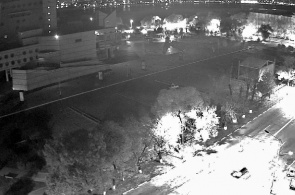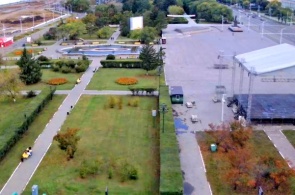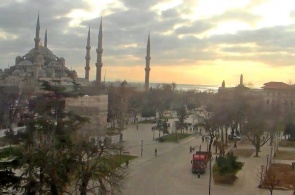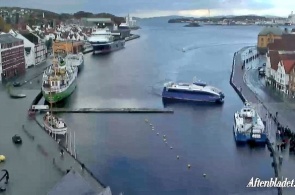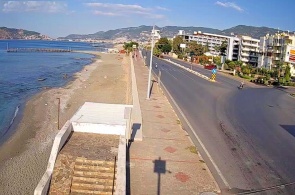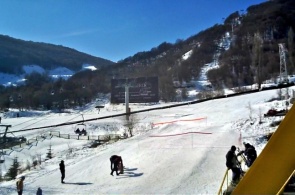The City Of Blagoveshchenskis the administrative center in the Amur region. It is located on the left Bank of the ancient Cupid, on the other hand which begins the Chinese border. The city was founded in 1856 as a Cossack village. Gradually there appeared a hut, a wooden Church and house of the military commander. The status of a city of Blagoveshchensk has received in 1858, after the signing of the Aigun Treaty with China, under which the left-Bank part of the Amur river began to belong to the Russian Empire. In the late nineteenth century there has been a real industrial boom, with a subsequent increase in the population of new Russian lands. The city has many attractions, among which are the unique monuments of archeology. So, in the South-Eastern outskirts of the city there is a cemetery of real dinosaurs. By the way, Blagoveshchensk is the world centre for the study of dinosaurs. Archaeological excavations of such unique expertise is carried out for a century, and during that time, scientists were able to explore the 10,000 m2 site. First found in the coastal zone of the Amur river to fossil remains of these monsters was about 65 million years. A logical continuation of the theme "dinosaurian" is the Annunciation Museum of paleontology, where there are hundreds of remains of different dinosaur species. Another fascinating place in the city is a Museum appeared in the city in the late XIX century, when the far East with working visit was visited by the crown Prince Nicholas. The first Museum exhibition was an exhibit of gold nuggets and gold bars, as well as photographs and models of local mines. In the modern Museum's collection is an amazing slice objects Ustyuzhenskoe meteorite paraphernalia of the ancient shamans, ancient numismatic collection, a variety of archaeological value, as well as clothing, household items, weapons and Handicrafts of the indigenous peoples of the far East region. Among the architectural landmarks of Blagoveshchensk surely deserves special attention triumphal arch, one of several such structures erected in various cities of the far East to the visit of the heir to the Russian throne. Unfortunately, the primary building was destroyed by the impetuous elements, but had conducted a global reconstruction and recovery of this beautiful monument of ancient Russian architecture.
More details
The Blagoveshchensk webcam is installed at the intersection of Bedny and Komarova streets. It covers the adjacent territories, parking lots, and pedestrian zones. The camera shows the everyday life of the city, and the video radiates an atmosphere of a comfortable urban environment. The broadcast is available in real time.
Blagoveshchensk, Russia
06.01.25
Web camera in real-time broadcasts of Public cultural center of Blagoveshchensk. EAC is the main place where all major city concerts, shows and other cultural events.
Blagoveshchensk, Russia
28.09.19
The webcam placed on the building of the jubilee, around the Central square in the capital of Amur region is Blagoveshchensk. In sight is the intersection of the street Lenin from street of 50 years of October, as well as beautiful city quay and the opposite Bank of the Amur, where are seen the buildings of the Chinese city of Heihe.
Blagoveshchensk, Russia
27.09.15
popular camerasshow all
Sultanahmet or Blue mosque is a work of art of Turkish-Islamic architecture. Its construction began in 1609, the construction work took seven years to a 19-year-old Sultan. The name of the mosque was, due to its interesting and unique finish.
Istanbul, Turkey
08.02.14
Stavanger, a town in the commune of Norway, located in the South-Western part of the country, on the Peninsula, rich in minerals. Tanager combines the influence of foreign organisations such as NATO and oil companies. The camera will shoot the harbour and the promenade of the city.
Stavanger, Norway
03.11.13
A webcam broadcasts the district of Tosmur - quiet location in the Eastern part of Alanya, located only five kilometres from the city centre. Its rural way of life and the beauty of untouched nature attract tourists.
Alanya, Turkey
10.11.18
Shark Island or in English of Shark island, located in the harbour city of Sydney, the suburb of Point Piper. The locals, the natives named the island Boambilly, which translated means Shark island. After all, this name is not casual, because it's mean and looks like a shark fin.
Sydney, Australia
31.10.13
The webcam is installed on site Alva. Tsaghkadzor ski resort town in Armenia. Tsaghkadzor is a beautiful mountainous area among deciduous forests, with a pleasant winter climate, and clean fresh air. The highest point is 1800 meters. The truss type is a classic, divided into three.
Tsakhkadzor, Armenia
18.01.14


